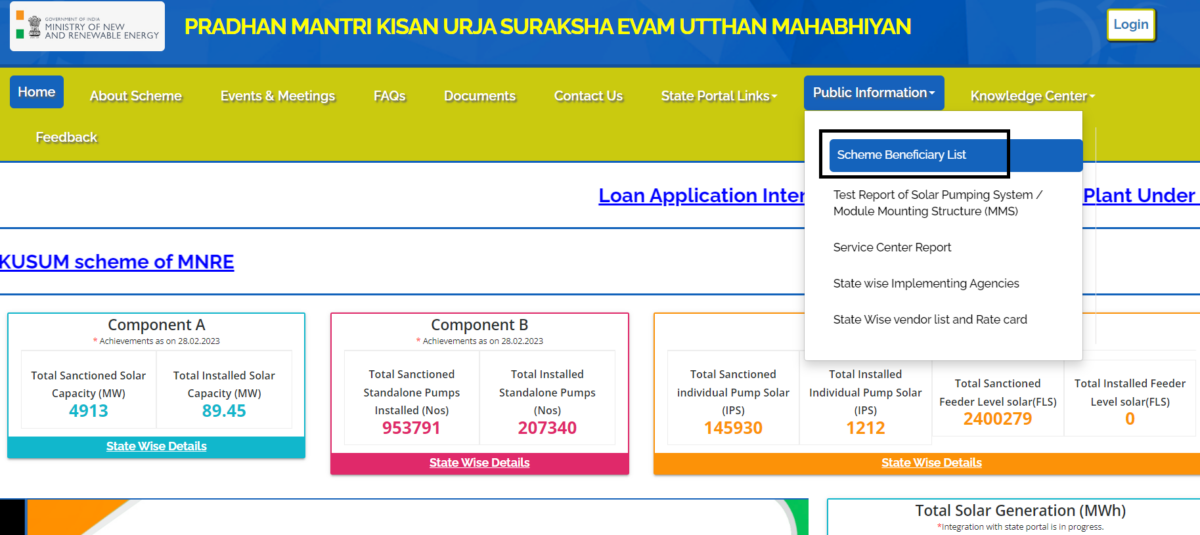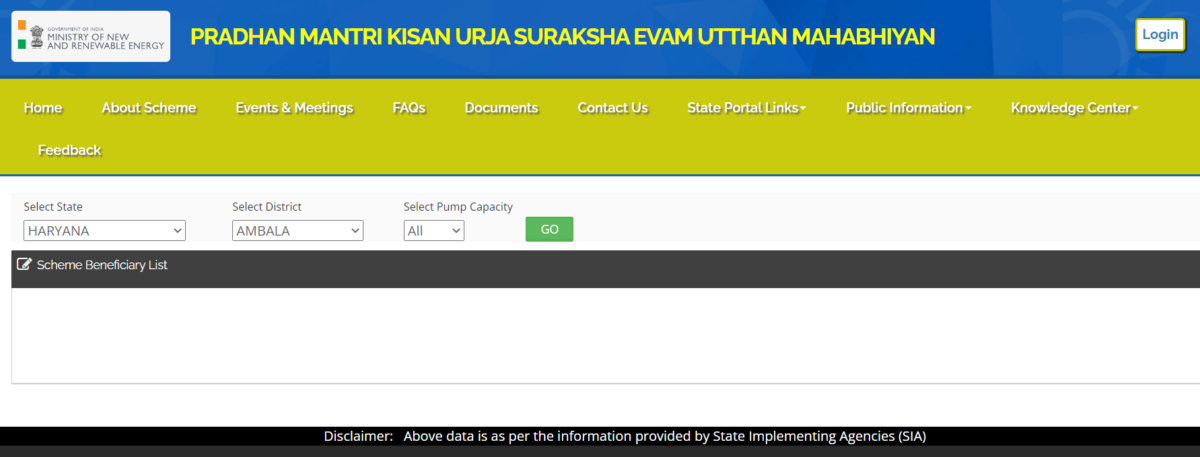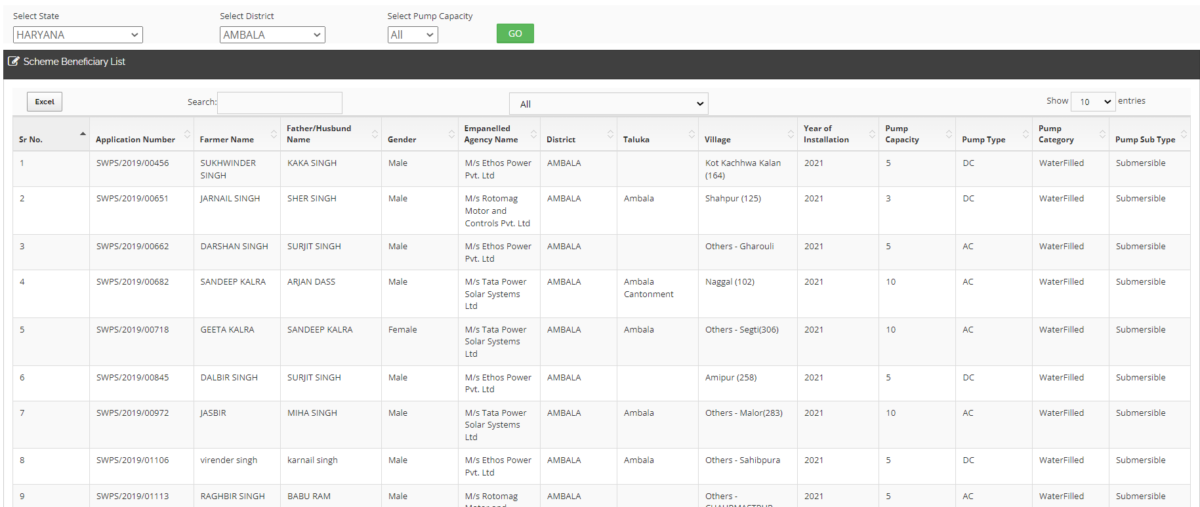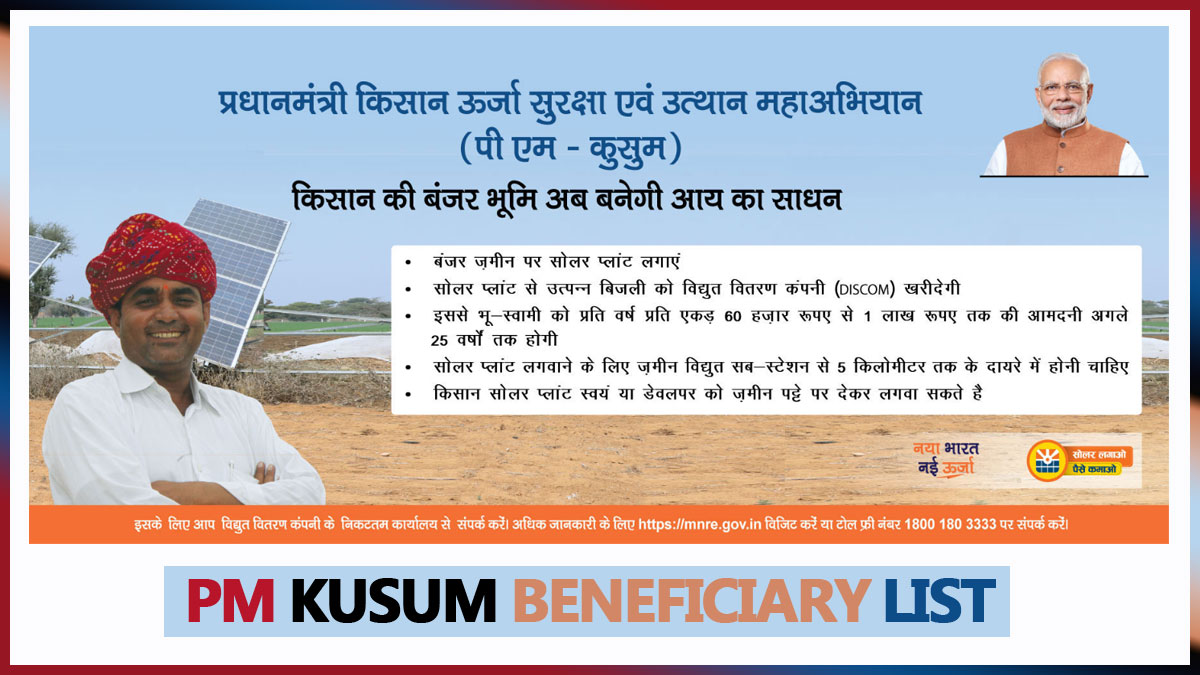PM Kusum beneficiary list 2025 has been made publically available at official website at pmkusum.mnre.gov.in. Ministry of New and Renewable Energy (MNRE) has released the Pradhan Mantri Kisan Urja Suraksha evam Utthan Mahabhiyan (PM Kusum Scheme) list of beneficiaries online. In this article, we will tell you about the complete process for checking PM Kusum Yojana beneficiaries list.
PM Kusum Beneficiary List 2025
STEP 1: Firstly, visit the official website of PM Kusum scheme at pmkusum.mnre.gov.in
STEP 2: On the homepage, go to “Public Information” section and click “Scheme Beneficiary List“.

STEP 3: Direct link for PM Kusum beneficiary list – https://pmkusum.mnre.gov.in/landing-Public_Information.html
STEP 4: Then PM Kusum scheme status checking page will open as shown below:-

STEP 5: Select state, district, pump capacity and click “Go” button to check PM kusum yojana list of beneficiaries.

STEP 6: In the opened PM Kusum beneficiary list, you can check application number, farmer name, father/husband name, gender, empanelled agency name, district, taluka, village, year of installation, pump capacity, pump type, pump category, pump sub type.
State/UT-wise Details of Beneficiaries under PM KUSUM Scheme
Here is the state / union territory wise details of beneficiaries under PM Kusum Scheme as on 28 February 2023:-
| State | Farmers Benefitted (Nos.) |
| Arunachal Pradesh | 126 |
| Gujarat | 2132 |
| Haryana | 44325 |
| Himachal Pradesh | 534 |
| Jammu & Kashmir | 499 |
| Jharkhand | 12107 |
| Karnataka | 314 |
| Kerala | 51 |
| Madhya Pradesh | 6790 |
| Maharashtra | 47978 |
| Manipur | 28 |
| Meghalaya | 35 |
| Odisha | 1223 |
| Punjab | 12459 |
| Rajasthan | 57692 |
| Tamil Nadu | 2751 |
| Tripura | 1654 |
| Uttar Pradesh | 17614 |
| Uttarakhand | 316 |
| West Bengal | 20 |
| Total | 208648 |
About PM Kusum Yojana
PM-KUSUM Scheme consists of following three components:
- Component A: installation of aggregated 10,000 MW capacity of small solar power plants, each of capacity up to 2 MW on the barren/fallow/pasture/marshy/ cultivable land of farmers.
- Component B: installation of 20 lakh standalone solar water pumps; and
- Component C: solarization of 15 lakh existing grid-connected agriculture pumps including through feeder level solarisation.
PM Kusum Yojana was expanded in November, 2020 with an increased target of 30,800 MW of solar power capacity. As on 28.02.2023, a total of 89.45 MW capacity has been installed under Component-A and around 2.09 lakh pumps have been reported installed/ solarized under Component-B and Component-C combined. This is equivalent to about 1,140 MW of installed solar capacity. State/UT-wise details of the farmers benefitted under the Scheme, including the State of Rajasthan, are given in Annexure.
The pace of implementation of the Pradhan Mantri Kisan Urja Suraksha evam Utthaan Mahabhiyan (PM-KUSUM) was significantly affected due to the COVID-19 pandemic and State Implementing Agencies sought extension in the time-line for execution of projects under the Scheme. Ministry of New & Renewable Energy (MNRE) has also conducted third party evaluation of PM Kusum Yojana and based on the recommendations, the Scheme has been extended till 31.3.2026.
MNRE is monitoring implementation of the Scheme through regular meetings with States on weekly/fortnightly basis. The State Implementation Agencies are also required to submit progress reports on monthly basis. These mechanisms help in effective monitoring of the Scheme.


Farmers’ Income: The scheme aims to support farmers in generating additional income by utilizing their barren or fallow lands for solar power generation.
Solar-Powered Irrigation: It promotes the installation of solar pumps to meet the irrigation needs of farmers, thus reducing their dependence on traditional electricity sources.